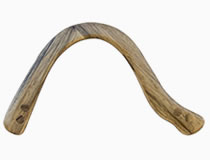If you need a boomerang and you have never dealt with it in practice, this article is for you.
There are a huge number of shapes and types of boomerangs. Read more about this in the article categories of boomerangs. When choosing the first boomerang, it is best to focus on returning models. They will give the first idea of how a boomerang flies and how it needs to be launched. Later in the article we will talk only about returning boomerangs.
Does he always come back?
No, not always. The prevailing opinion that the boomerang always returns is not entirely true. In order for the boomerang to return to you, you need to make some efforts. Just like that, he won't come back. If you throw it at random, then no miracle will happen, it will fly at random. Or maybe it won't fly at all. Only the laws of physics work here.
The boomerang returns if:
- This is a well-made, returning boomerang.
- The throwing technique is followed, i.e. the throw is made with the correct inclination and sufficient force.
- Weather conditions make it possible to launch and control its flight.
Which one should I choose?
As already mentioned, there are a lot of boomerang shapes. But the first thing you should pay attention to is the size and weight. Large boomerangs, they are usually heavy, can only be launched by an adult male from 16-18 years old. You need to have a strong enough hand to make an energetic throw.
For a child of 7 years old, a small and very light (as if made of thin cardboard) boomerang is suitable. It is safe and easy to use.
Of our boomerangs, Arrow is the easiest to launch. We recommend it from the age of 12, but even younger athletes can handle it. For a full review of our collection with recommendations, see the Boomerangs page.
What should you choose? All our returning boomerangs are quite easy to operate and any physically developed and active adult can handle them. It may take a little training, but it's not very difficult.

If you want your boomerang to fly and return, it is better to buy from the manufacturer, who himself checks his products in practice, can show and prompt if something does not work out.
As a rule, the arsenal of a real boomerang lover is not limited to one model. Some boomerangs fly well in light winds (Hook, Hare), and others work well without wind (Fan, Fan Laminated). The three- or four-bladed models are very stable in flight and easy to catch. Models in the form of a hook, or similar to Hook, fly a little further and longer.
First launches
You need a large outdoor area with soft ground without obstacles, and good weather with or without light wind. The first launches are likely to be static, and the boomerang will fly away and fall. Keep this in mind when choosing a place to launch. To avoid damage, it is best to do this on a grassy surface or sand. Take a boomerang, and make a throw against the wind, about 45 degrees to the right.

As a rule, you do not know what to expect from the first launch of an unfamiliar boomerang, how it will fly, and how it should be thrown. In such cases, make several test throws with average strength or slightly weaker, with an inclination from the vertical plane of about 30-40 degrees, so to speak "with a margin", and throw higher.

This is done firstly in order to just see how the boomerang will fly with such a throw, and secondly, to warm up the hand and fingers. Then, after making 2-3 such throws, you can start adjusting the flight. If the boomerang flies too high, then gradually reduce the angle, making it more vertical. If the boomerang falls halfway, then try to throw harder or / and tilt it more (closer to the horizontal position).
Next, watch how the flight changes and try to get the boomerang back to you. In all cases, the throw should be energetic, with good rotation.
Don't wake up if you don't get it right away. Perhaps the weather conditions are not quite suitable for your boomerang, or you need to work on the throw more. Sometimes it takes some time to understand how your boomerang behaves in flight and learn how to throw it properly.
I'll give you an example from my practice.
"At the next series of tests and video recording, I decided to start with a warm-up, with a boomerang, which I launched just the other day. I throw it, but it doesn't fly in any way. It doesn't come back. I try both ways. It doesn't work. I postponed it, and started launching other boomerangs. After 15-20 minutes, I return to the first one, which did not want to fly in any way, I throw it, and ... it immediately flies as it should, with an accurate return!"
This example shows how important the correct launch is.
When you learn how to return your boomerang, you can try games and competitions with a boomerang. This is a really good warm-up, interesting and useful.
Good luck with your throws!



